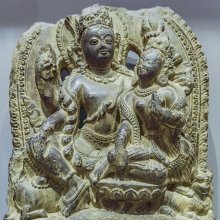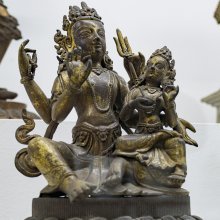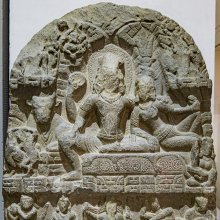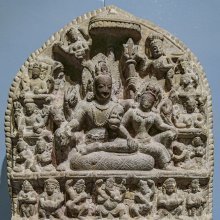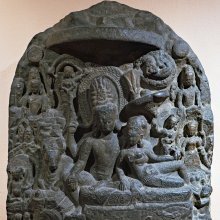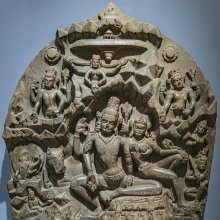Umamaheshvara, Umāmaheśvara, Uma-maheshvara: 5 definitions
Introduction:
Umamaheshvara means something in Hinduism, Sanskrit. If you want to know the exact meaning, history, etymology or English translation of this term then check out the descriptions on this page. Add your comment or reference to a book if you want to contribute to this summary article.
The Sanskrit term Umāmaheśvara can be transliterated into English as Umamahesvara or Umamaheshvara, using the IAST transliteration scheme (?).
Images (photo gallery)
(+5 more images available)
In Hinduism
Purana and Itihasa (epic history)
Source: Cologne Digital Sanskrit Dictionaries: The Purana IndexUmāmaheśvara (उमामहेश्वर).—To be worshipped in ādityaśayana Image of; worship of; either four or two hands; three eyes; clad in elephant's skin; surrounded by Jaya and Vijaya, and also Kārtikeya and Vināyaka.*
- * Matsya-purāṇa 55. 5; 60. 42; 64. 22; 260. 11-21.
Umāmaheśvara (उमामहेश्वर) or Umāmaheśvaravrata refers to type of Vrata (“religious observances”), according to the 10th century Saurapurāṇa: one of the various Upapurāṇas depicting Śaivism.—Accordingly, the Umāmaheśvara-vrata is described in the Saurapurāṇa 43.1-17. The Sūta gives the tradition of receiving knowledge about this vrata. In the past it was told by Śaṅkara to Pārvatī and Skanda. Skanda imparted it to Agastya and the latter instructed it to Vyāsa and from Vyāsa the Sūta received this knowledge. About the efficacy of this vrata it is said that it destroys all sins and bestows dharma, artha, kāma and mokṣa.
Accordingly:—
This Umāmaheśvara-vrata is observed on the full-moon day, new-moon day, the fourteeth and the eighth tithis, at night. The observer should maintain celebacy, eat haviṣya, be truthful and control the sense-organs. At the end of a year image of Umāmaheśvara is to be made either of gold or silver. Bathing the idol with pañcāmṛta and having decorated it with cloth, flower, the observer should worship the idol with various eatables according to injunction. The idol should be furnished with banner, canopy and cāmara. The preceptor should be worshipped with cloth, ornaments etc. with devotion. Dakṣiṇā should be given and devotees of Śiva are to be fed.
The observer of this Umāmaheśvara-vrata should place the idol, which is worshipped, in pure copper-plate and having covered with white cloth should pay obeisance. Constructing the Śiva temple the observer should install the image on the vedī with the sound of conch, bugles etc. and proclaim (nivedayet) this vrata to Śaṃbhu. Having circumambulated Śiva he should pray for pardon. The person performing this vrata gets all his desires fulfilled.
Note: This Umāmaheśvara-vrata is also found mentioned in the Bhaviṣvapurāṇa, Uttarakhaṇḍa 23.1-28. Liṅgapurāṇa I.84.1-72, Kṛtyakalpataru, Vratakhaṇḍa 414-416; Hemādri’s Vratakhaṇḍa II 395 and 691-693.

The Purana (पुराण, purāṇas) refers to Sanskrit literature preserving ancient India’s vast cultural history, including historical legends, religious ceremonies, various arts and sciences. The eighteen mahapuranas total over 400,000 shlokas (metrical couplets) and date to at least several centuries BCE.
Pancaratra (worship of Nārāyaṇa)
Source: Shodhganga: Iconographical representations of Śiva (pancaratra)Umāmaheśvara (उमामहेश्वर) or Umāmaheśvarasaṃhitā is the name of a Vaiṣṇava Āgama scripture, classified as a tāmasa type of the Muniprokta group of Pāñcarātra Āgamas. The vaiṣṇavāgamas represent one of the three classes of āgamas (traditionally communicated wisdom).—Texts of the Pāñcara Āgamas are divided in to two sects. It is believed that Lord Vāsudeva revealed the first group of texts which are called Divya and the next group is called Muniprokta which are further divided in to three viz. a. Sāttvika. b. Rājasa. c. Tāmasa (e.g., Umāmaheśvara-saṃhitā).

Pancaratra (पाञ्चरात्र, pāñcarātra) represents a tradition of Hinduism where Narayana is revered and worshipped. Closeley related to Vaishnavism, the Pancaratra literature includes various Agamas and tantras incorporating many Vaishnava philosophies.
Languages of India and abroad
Sanskrit dictionary
Source: Cologne Digital Sanskrit Dictionaries: Aufrecht Catalogus CatalogorumUmāmaheśvara (उमामहेश्वर) as mentioned in Aufrecht’s Catalogus Catalogorum:—Advaitakāmadhenu vedānta. Burnell. 94^b. Tattvacandrikā vedānta. Burnell. 91^b. Oppert. Ii, 1753. 7088. Taptamudrāvidrāvaṇa vedānta. Oppert. Ii, 6280. Prasaṅgaratnākara kāvya. Burnell. 164^a. Taylor. 1, 226. 337 (Prasaṅgaratnāvalī). Oppert. Ii, 10051. Rāmāyaṇaṭīkā. Oppert. Ii, 4885.
[Sanskrit to German]
Sanskrit, also spelled संस्कृतम् (saṃskṛtam), is an ancient language of India commonly seen as the grandmother of the Indo-European language family (even English!). Closely allied with Prakrit and Pali, Sanskrit is more exhaustive in both grammar and terms and has the most extensive collection of literature in the world, greatly surpassing its sister-languages Greek and Latin.
See also (Relevant definitions)
Partial matches: Maheshvara, Uma.
Starts with: Umamaheshvaramurti, Umamaheshvarasamhita, Umamaheshvarasamvada, Umamaheshvarastotra, Umamaheshvaravrata, Umamaheshvaravratakalanirnaya, Umamaheshvaravrataprayoga, Umamaheshvaravratavidhi.
Full-text: Umamaheshvaravrata, Advaitakamadhenu, Prasangaratnakara, Subhashitaratnavali, Tattvacandrika, Prasangaratnavali, Durvaganaptivrata, Durvaganapti, Lakshmidharabhatta, Umamaheshvarasamhita, Uma, Pratimalakshana, Shula, Somasiddhanta, Vijaya, Ramayana.
Relevant text
Search found 18 books and stories containing Umamaheshvara, Uma-maheshvara, Uma-mahesvara, Umā-maheśvara, Umamahesvara, Umāmaheśvara; (plurals include: Umamaheshvaras, maheshvaras, mahesvaras, maheśvaras, Umamahesvaras, Umāmaheśvaras). You can also click to the full overview containing English textual excerpts. Below are direct links for the most relevant articles:
The Skanda Purana (by G. V. Tagare)
Chapter 18 - Observance of the Vow of Umā-Maheśvara < [Section 3 - Brāhmottara-khaṇḍa]
Chapter 49 - King Kalaśa Turns into a Tiger < [Section 1 - Tīrtha-māhātmya]
Chapter 48 - Installation of Umā-Maheśvara < [Section 1 - Tīrtha-māhātmya]
Early Chola Temples (by S. R. Balasubrahmanyam)
Muktesvaram < [Chapter XIV - Conclusion]
Inscriptional References < [Chapter VII - Uttama Chola, Madhurantaka]
*Temples of the age of Uttama Chola* < [Chapter X - Historical Survey]
The Linga Purana (by J. L. Shastri)
Chapter 84 - The holy rite of Umā-Maheśvara (umāmaheśvara-vrata) < [Section 1 - Uttarabhāga]
Jainism in Odisha (Orissa) (by Ashis Ranjan Sahoo)
Jaina Antiquities in Kendrapara District < [Chapter 3: Survey of Jaina Antiquities in Odisha]
A History of Indian Philosophy Volume 3 (by Surendranath Dasgupta)
Part 22 - Raṅgācārya < [Chapter XX - Philosophy of the Rāmānuja School of Thought]
Sanskrit sources of Kerala history (by Suma Parappattoli)
2. Kerala in the Puranas < [Chapter 6 - Miscellaneous Sanskrit works bearing on Kerala history]
Related products
